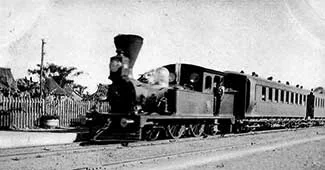The State of Philippine Railroads in 1902 and American Attempts to Improve It, Including New Lines in Batangas
On 18 March 1902, the United States Senate directed Elihu Root, the Secretary of War, to provide “a statement of the legal and traffic relations between the railroads in the Philippine Islands and as to the charters and ownership of such railroads1.” Root’s reply was succinct, and included this statement which basically summed up the state of Philippine railroads at the time:
“There is but one steam railroad of any consequence in the Philippine Islands. It connects the city of Manila with Dagupan, on the Gulf of Lingayen. It is owned by an English corporation named the Manila Railway Company, Limited.” This company obtained the rights to build and operate the railway from the Spanish colonial government in 1885.
 |
| A train of the Batangas Railways. Image source: Posted by user Pinai on the Indonesia v the Philippines discussion board on www.city-data.com. |
Also existing in 1902 was a railway for steam-powered trams2 which ran from Manila to Malabon via Caloocan. This was the first railway system built in the Philippines3. It was operated by a company owned by a Señor Don Jacobo Zobel de Zangronis, who had obtained the concession from the Spanish colonial government in 1884.
In Mindanao during the Spanish colonial era, construction of a military railroad planned to run from Iligan to Lake Lanao had already been started, but the tracks had since been torn up by locals. There were also short railway lines in the island of Cebu which connected the mines to the ports.
Other than these, there were no other significant railroad tracks or train services in the country, or at least as far as Root was aware.
Because of the abject state of railways in the country, before long the new American colonial government began soliciting “proposals or bids for concessionary contracts or grants with and by the Philippine government (meaning, under American control), in aid of the construction, equipment, maintenance and operation of the lines of railway in the Philippine Islands…”
The railway system which the American colonial government envisioned included the construction of lines in Luzon as well as the islands of Panay, Negros, Cebu, Leyte and Samar. The proposed railroad network for Luzon included the laying down of tracks and the operation of train service to Batangas.
This idea was, in fact, not new. When a Spanish royal decree dated 11 May 1883 was issued ordering the construction of railway lines in Luzon, among those included was a line “from Manila to Taal by way of Calamba.”
The former Spanish government official and historian Manuel Sastron must have been privy to this instruction because in his 1895 book “Batangas y Su Provincia4,” he made mention of the impending construction of this very line. From Calamba, the line would go south to the town of Batangas before curving north to Taal, presumably through Bauan.
Sastron wrote this in the chapter devoted to the town of Cuenca, saying that were this line to be completed, the town could become a “place of recreation” for the wealthy people in Manila who could then avail of its “peaceful and healthy life.” As we now know, the line was never built during the Spanish era.
The line which the Americans had in mind was similar and was described in the official invitation to bid released by the War Department on 12 June 1905:
“A line from the city of Manila to the town of Batangas, in the province of Batangas, on the Bay of Batangas, approximately 70 miles (112.7 kilometers) miles in length, with two branches therefrom – one from Calamba, in the province of Laguna, to Santa Cruz, in the same province, a distance approximately of 25 miles (40 kilometers); and the other from the town of Lipa or other convenient junction point in Batangas to the town of Lucena, in the province of Tayabas (present-day Quezon), a distance approximately of 35 miles (56 kilometers), or a total for the Manila, Batangas and Santa Cruz line of 130 miles (209 kilometers).”
On 14 December 1905, the New York-based Speyer and Company submitted a proposal which included, among others “a line from Manila to Batangas and Bauan, with the right to operate… from Santo Tomas to Lucena…” I am as yet unable to confirm that it was, indeed, this company which built the railroad system in Batangas.
All the initial bids were rejected “for the reason that they included conditions contrary to the terms of the original invitation.” However, new invitations were immediately issued with “somewhat modified terms.”
According to the web site Laguna Railways, the Calamba to Bauan via Batangas line was eventually built with a junction in Malvar. From this town, the line branched out en route to Alaminos in Laguna5. By 1917, the American colonial government would nationalize the railway system in the country and take over the operation of its lines, including the one that led to Batangas and Bauan.
2 Trams are typically lighter and shorter than conventional long-haul trains. “Tram,” Wikipedia.
3 “The Railways in Philippine History,” by Augusto V. de Viana, PhD, published 2008, online at Laguna Railways.
4 “Pequeños Estudios, Batangas y Su Provincia,” by Manuel Sastron, published 1895.
5 “Google Earth Philippine Railroad Triangle Collection,” online at Laguna Railways.

